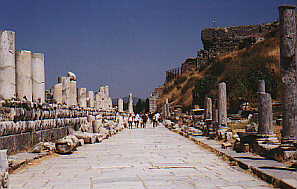
This street is the main route from the seaport. It has always been a sight for tourists, but it has been occupied by Greek soldiers, scholars and drama performers. It has also been occupied by Roman sailors, soldiers and merchants. It was walked by St. Paul and his disciple Timothy (a native of Ephesus) and by St. John the beloved apostle and the Virgin Mary. Christians have both been welcomed and searched out for arrest in this street.

This mosaic walkway runs immediately in front of the homes of wealthy residents. It is lays next to the common street, separated by the colonnade, seen on the right.
These homes had hot and cold running water.

Temples to Greek and Roman gods and statues of
Roman emperors line the streets.
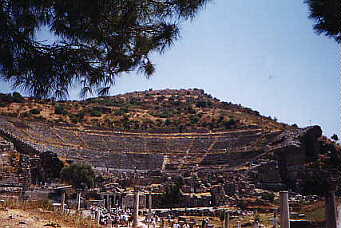 The stadium was the center of diversion for all the people, both the common
and elite.
The stadium was the center of diversion for all the people, both the common
and elite.
During its Greek period the stadium was an amphitheater where Greek comedies and tragedies were performed.
The Romans removed the stage and built an arena in its place, providing a platform for epic games and gladiator contests.
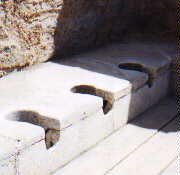 The public toilet was the daily source of gossip and of the comings and goings
of the city's business. This toilet could seat over 40. The "crowd"
was entertained by an orchestra, to help keep secrets passed between seat-mates
and probably to soften the natural sounds of the business at hand.
The public toilet was the daily source of gossip and of the comings and goings
of the city's business. This toilet could seat over 40. The "crowd"
was entertained by an orchestra, to help keep secrets passed between seat-mates
and probably to soften the natural sounds of the business at hand.
Running water beneath the toilet removed the by-products, and fresh water running in a trough at the feet provided the means for personal hygiene.
 The Library is the predominate structure remaining in the city.
The Library is the predominate structure remaining in the city.
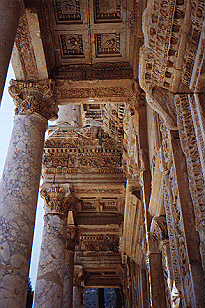 The facade is an amazing structure made of carved marble. It is
decorated with statues and elaborate patterns.
The facade is an amazing structure made of carved marble. It is
decorated with statues and elaborate patterns.
 This view from a hill in Selcuk gives a perspective of the area.
This view from a hill in Selcuk gives a perspective of the area.
Ephesus is located just behind the two low hills in the distance.
 The taller hill behind the lower hills is the site of the Virgin
Mary's home where history indicates she was brought by St. John
after persecutions in Jerusalem.
The taller hill behind the lower hills is the site of the Virgin
Mary's home where history indicates she was brought by St. John
after persecutions in Jerusalem.
Excavation and restoration of the house shows the original foundation dates to the 1st century AD. The building was restored in the 500s and was reconstructed in the 1950's.
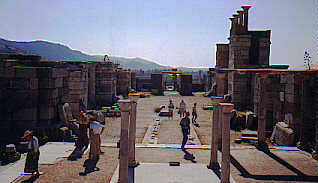 The hill from where the above picture was taken is the site of
the basilica of St. John the Apostle, and the place of where he was buried.
The hill from where the above picture was taken is the site of
the basilica of St. John the Apostle, and the place of where he was buried.
The basilica was built in the 500's by Justinian.
Byzantine tradition has long held the tomb of the Apostle John is in Ephesus.
Another tradition has Ephesus as the place where Mary Magdalene died.